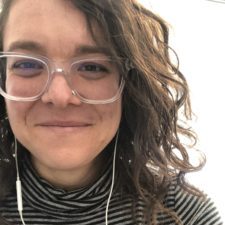
Consider Disability
I was on educational leave in the fall and working, primarily, on a religion and disability textbook. Of the many things I learned (one of which was how very little it turns out I know about religion, the subject for which I have my doctorate; this was humbling!), the fact that there is relatively little treatment of disability in religious studies became quite clear to me. Disability goes unmentioned in canonical texts in the field and introductory textbooks, including the one from which I assign chapters. Unless I was reading specific volumes devoted to the topic--or poking around our disciplinary journal, which we’re lucky to have--it rarely came up.
As a person who attends to disability regularly in lots of parts of my personal and professional life (e.g., this recent presentation on inclusive pedagogy for AAR), I also have to admit that I haven’t really integrated disability into my courses, besides the specific one I teach on Religion and Disability. In the past, I’ve made no mention of disability in my lower-level, introductory Religions of the World classes or my upper-level electives, such as Religion and Film or Race and Religion. This is not the case with other markers of identity—gender, class, race—which I routinely note, represent, and try to get students to reflect on. A quick search of our Wabash blog posts shows that disability is not a popular topic. And, in general, “higher ed has been slow to recognize disability as an identity group or include it in programming around diversity and inclusion.” Some scholars, like Jay Domage in Academic Ableism, have even argued that higher education in the U.S. has been specifically designed to exclude people with disabilities.
Disabled people account for the largest minority group in the world. On college campuses, we really don’t know just how many students and colleagues have a disability because there is so much underreporting, likely due to all the barriers to disclosure. It’s a lot, though. And, as with any demographic, including the religious, there is immense diversity within the disability community. Disabilities can range from hearing to learning, from movement to mental health. They can be lifelong, from birth, or shorter term. Some folks are proud of their disability and wouldn’t change it for the world, believing it gives them gifts and connections they wouldn’t have otherwise. Other folks with disabilities experience impairment and suffering and wish their lives had turned out differently. Some can pass, although it’s not always beneficial to them. Others have disabilities that are always or immediately apparent to others. Some people prefer “person-first” language (e.g., “a person with ADHD”); others prefer “identity-first” language (“a deaf person”), which allows them to claim, unapologetically, disability as a central and important part of who they are. People with the same disability can experience it very differently. What binds people together in this group is the way society is still not designed for them and the barriers they experience (environmental, social, legal) that result.
Awareness and understanding about disability remains woefully lacking on college campuses. COVID has not helped. College students with disabilities experience discouragement, debasement, insecurity, isolation, and cycles of disempowerment. Accommodations are resisted, disabilities are disbelieved. And, when we talk about disability, we tend to think only of students. However, of course, our colleagues may have disabilities too.
In our religion classrooms, we can assume there will be students with disabilities enrolled. We don’t need to wait for disclosure, some “accommodation” letter about a single person, to begin considering how to make our courses accessible and welcoming. Let’s be proactive, rather than reactive. This is the entire point of Universal Design for Learning, which I encourage everyone to spend time learning more about. (UDL benefits everyone, not just specific individuals with specific disabilities.) The gist is to preemptively assume variability and then to design for it, proliferating options and providing multiple entry points to the learning experience. (And yes, it’s also basic stuff like turning on closed captions whenever you show a video in class or making sure podcasts you assign have transcripts.) It’s about moving away from conceiving disability as deficit, to embracing the opportunities and assets of having a diverse student population in our classrooms.
Leave a Reply